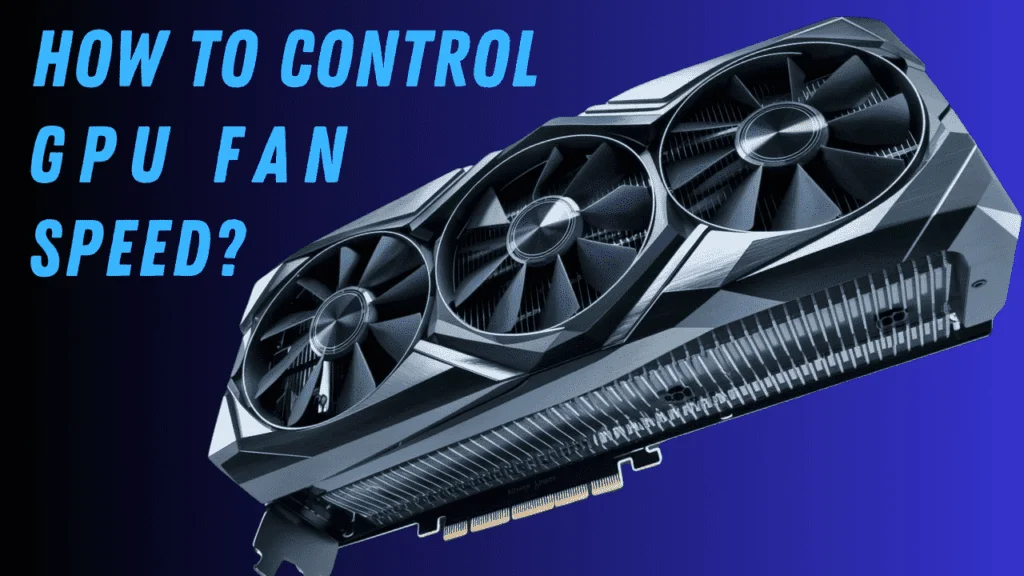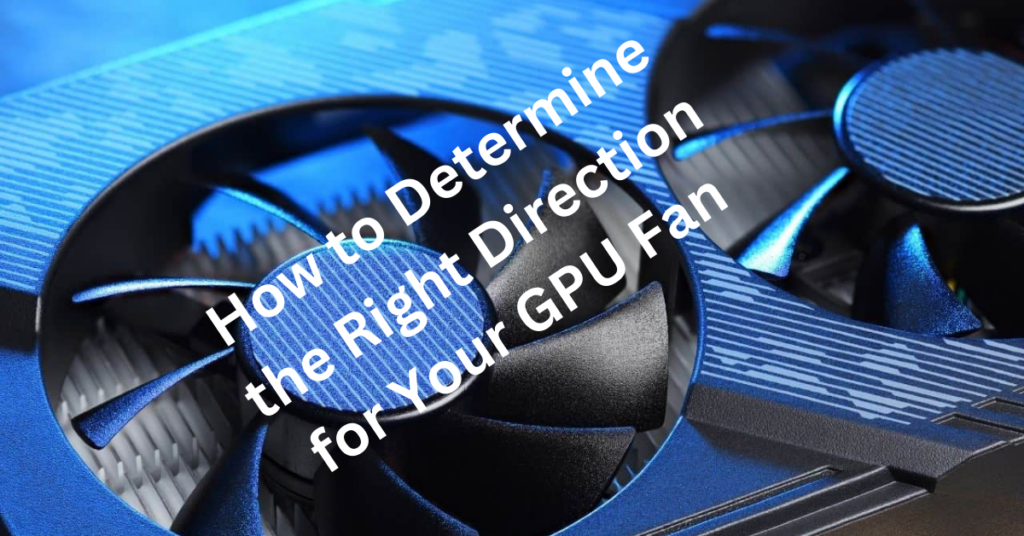Checking your GPU fan speed can be surprisingly simple. I first tried it to monitor my gaming performance and found that using built-in software like NVIDIA Control Panel or third-party tools like MSI Afterburner made it super easy. I can watch fan speed and ensure my GPU stays cool during intense gameplay.
.
Monitoring your GPU fan speed is critical to keeping your graphics card cool and performing optimally. You can easily spot issues, adjust settings, and extend your GPU’s lifespan by checking the fan speed.
Stay tuned as we discuss everything you need to know about evaluating GPU fan speed! We’ll cover simple steps, helpful tools, and tips to keep your GPU cool and running smoothly.
How To Control GPU Fans Speed?

Check Your GPU Software:
Most graphics cards come with software like NVIDIA GeForce Experience or AMD Radeon Software. These programs let you control various GPU settings. Open the software and find the fan control section. If you don’t have the software, you can download it from your GPU manufacturer’s website.
Enable Manual Fan Control:
Once in fan settings, you’ll usually see an option for “automatic” or “manual” control. Switch to manual to take control of fan speed. This lets you set fan speed based on your needs. Manual mode gives you more control over cooling and noise levels.
Adjust Fan Speed:
Use the slider or type in a specific speed percentage. Start with a low fan speed to reduce noise. Increase the speed if your GPU is getting too hot during heavy use.
Higher fan speeds can help keep your GPU cool under heavy loads.
Save and Apply:
Once you set the speed, find the “Save” or “Apply” button. Click it to activate the new fan settings. This keeps the fan running at your preferred speed. Remember to apply settings each time you make changes.
Monitor Temperatures:
Monitor your GPU temperatures, especially during gaming or intense tasks. If temperatures get too high, increase fan speed. This helps prevent overheating and keeps your GPU safe. Most software shows temperature readings for easy monitoring.
How to adjust the GPU fan speed?
To adjust GPU fan speed, open your GPU software, such as NVIDIA GeForce Experience or AMD Radeon Software. In the settings, switch the fan control from automatic to manual to choose your fan speed. This lets you control cooling and noise levels.
Use the slider to adjust fan speed, starting low to reduce noise and increasing if your GPU gets hot. Click Apply or Save to activate the new setting. Monitor temperatures, and adjust fan speed as needed to keep the GPU cool.
Read More: GPU Fans Not Spinning – Complete Guide 2024!
How can I check if my GPU fans are not working?
- Listen for Fan Noise: You should hear the fans spinning when the GPU is under load. A lack of noise might mean they aren’t working.
- Check Fan Movement: Open your computer case and visually check if the fans are spinning. Run a GPU-intensive task to see if they activate.
- Use Monitoring Software: Programs like MSI Afterburner or GPU-Z can show fan speed data. If it shows “0 RPM,” the fans may not be working.
- Feel for Airflow: Place your hand near the GPU exhaust vents. Warm airflow indicates the fans are active.
- Check Temperatures: High GPU temperatures while idle or under light load might mean the fans are not running.
How to determine the right direction of GPU?

Check the GPU Label and Ports:
A GPU’s label and port layout can help indicate its correct orientation. Generally, the side with the HDMI, DisplayPort, or other output ports should face outward, towards the back of the computer case. This allows easy access for connecting cables to a monitor. Additionally, any branding or labeling on the GPU usually faces upright when the GPU is correctly oriented.
Locate the PCIe Slot on the Motherboard:
In desktop cases, the GPU connects to the motherboard via a PCIe slot, typically located near the bottom half of the motherboard. Align the GPU’s connectors with this slot. The correct direction means the GPU’s gold connectors should fit snugly into the PCIe slot, with the output ports facing the case’s back panel. Ensure the alignment matches this layout before inserting the GPU.
Align the GPU Bracket with Case Slots:
Most GPUs come with a metal bracket on one side, which aligns with the back of the computer case. This bracket has screws or clips that secure the GPU to the case once installed. Place the GPU so that the bracket aligns with the case slots; this stabilizes the card in the right direction. A correctly oriented GPU should sit flush against the case with no gaps.
Ensure Proper Clearance and Ventilation:
When installing the GPU, ensure enough space between it and other components. GPUs typically have cooling fans that need open space to function properly. Depending on your case design, position the GPU with its fans facing downward (in most cases) or facing a ventilated side. This placement prevents overheating by allowing airflow around the card.
Confirm with Power Cable Connections:
Once the GPU is inserted, check the power cable connection. Most GPUs require power cables connecting to the card’s top or side. The proper orientation places these connections in an accessible area where cables can be easily attached. An adequately aligned GPU will allow you to connect the power cables without bending or straining them.
How to check if my GPU fan has any problem:
Listen for unusual sounds to check if your GPU fan has a problem. A working fan should produce a steady, smooth noise when running. Grinding, rattling, or clicking sounds can indicate a problem with the fan. If you hear nothing, the fan may not be spinning, which could mean an issue with power or the fan itself.
You can also check by watching the fan while your computer is on. Open the case and look at the fan blades to see if they’re spinning. If the graphics-intensive program works correctly, running a graphics-intensive program can make the fan spin faster. If the fan stays still, stops suddenly, or spins inconsistently, it might need repair or replacement.
How to look at GPU fan speed Laptop:
To check the GPU fan speed on a laptop, use software like MSI Afterburner or HWMonitor. These programs show real-time fan speed data, usually in RPM (rotations per minute).
Open the software, find the fan settings, and locate the GPU fan speed. If no data appears, your laptop might not support fan speed monitoring directly, but you can still watch GPU temperatures to check if the fan is working.
Read More: Are GPU Fans Intake Or Exhaust – The Answer Will Surprise You!
GPU fan speed:
GPU fan speed controls how fast the fans spin to cool the graphics card. Higher speeds help keep the GPU cool during heavy tasks like gaming or video editing. Faster fan speeds can reduce heat but may cause more noise. Most GPUs adjust fan speed automatically based on temperature, but you can also set it manually using the software. Keeping the fan speed balanced is vital to prevent overheating without lowering the laptop.
Frequently Asked Questions:
1. What software can I use to monitor GPU fan speed?
You can use software like MSI Afterburner, GPU-Z, HWMonitor, or Speccy. These programs provide real-time data on fan speed and GPU temperatures.
2. Can I check GPU fan speed in the BIOS?
Some BIOS versions, including the GPU fan, allow you to monitor fan speeds. Restart your computer and enter the BIOS setup to check if this feature is available.
3. Why is my GPU fan speed not showing?
If the fan speed isn’t displayed, your laptop might not support direct fan monitoring, or the fan could be inactive due to low temperatures. Check if the GPU is under load, as the fan might only spin during heavy use.
4. How do I manually adjust GPU fan speed?
You can manually adjust the fan speed using software like MSI Afterburner. Open the program, enable manual fan control, and set your desired fan speed using the slider.
5. What is an average GPU fan speed?
Average GPU fan speeds vary by model and usage but typically range from 30% to 70% during standard tasks. Under heavy load, speeds can reach 100%, depending on the cooling needs.
Conclusion:
Monitoring your GPU fan speed is essential for maintaining optimal performance and preventing overheating. Using software like MSI Afterburner or NVIDIA Control Panel makes checking and adjusting fan speeds easy. Regularly monitoring the fan can help you identify issues early and extend your GPU’s lifespan. Keeping your GPU cool ensures a better gaming experience and overall system reliability.
.
